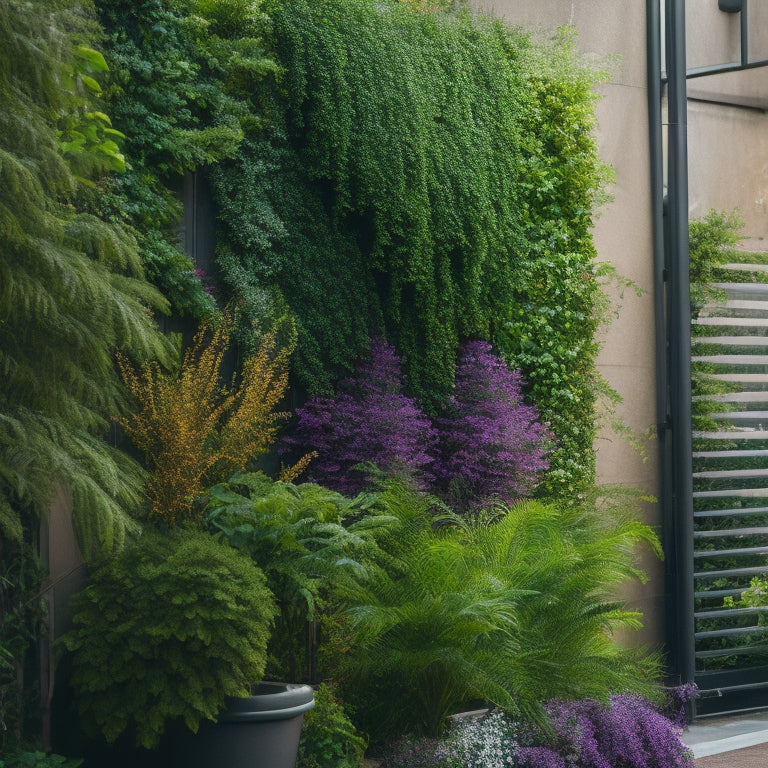
Why Go Vertical With Your Garden Design?
Share
By going vertical with your garden design, you'll maximize space in compact areas, reduce your environmental impact, and create a healthier environment. You'll utilize trellises, arbors, and wall-mounted planters to promote efficient growth, and select compact plant varieties to optimize your space. With vertical gardening, you'll enjoy a higher yield potential, up to 30% more than traditional gardening, and year-round gardening possibilities. Plus, you'll experience the aesthetic appeal of incorporating architectural features, achieving color contrast, and creating height variation. As you explore the world of vertical gardening, you'll discover even more creative ways to transform your outdoor space.
Key Takeaways
• Maximize space in compact urban areas and utilize container gardening for efficient use of limited space.
• Reduce water consumption, lower carbon emissions, and minimize the need for fertilizers and pesticides with eco-friendly practices.
• Create a healthier environment by incorporating green spaces and vertical elements for a sense of depth and airiness.
• Increase yields by up to 30% compared to horizontal gardens, maximizing every square foot of growing space.
• Achieve year-round gardening possibilities with seasonal adaptability and the ability to thrive in any climate or season.
Benefits of Vertical Gardening
By adopting vertical gardening, you can maximize your space while minimizing your environmental footprint. This innovative approach enables you to grow more plants in a smaller area while reducing water consumption and carbon emissions.
With vertical gardening techniques, you can create a lush oasis even in the most compact urban spaces, making it an ideal urban gardening solution. By utilizing walls, trellises, or freestanding structures, you can cultivate a diverse range of plants, from leafy greens to vibrant flowers, in a fraction of the space required by traditional gardening methods.
This not only saves space but also reduces the need for fertilizers, pesticides, and irrigation systems, resulting in a more sustainable and eco-friendly gardening practice. By incorporating vertical gardening into your urban gardening solutions, you can enjoy a thriving garden that not only beautifies your space but also contributes to a healthier environment.
With its numerous benefits, vertical gardening is an attractive option for anyone looking to make the most of their outdoor space while minimizing their ecological impact.
Space-Saving Succulent Displays
When designing a space-saving succulent display, you'll want to contemplate the layout and organization of your plants.
Succulent shelf divisions can help create a visually appealing, tiered effect, while also maximizing your vertical space.
Succulent Shelf Divisions
You can create visually striking Succulent Shelf Divisions by separating your plants into smaller, distinct sections using wooden or metal grids, which not only add texture but also maximize vertical space. This design approach allows you to showcase a variety of succulent species while maintaining a clean and organized look.
When selecting succulent shelf materials, consider the aesthetic you want to achieve. Wooden grids can add a natural, rustic touch, while metal grids can provide a sleek, modern look. You can also mix and match materials to create a unique succulent shelf style that reflects your personal taste.
To take your Succulent Shelf Divisions to the next level, experiment with different grid patterns and sizes. For instance, you can create a geometric pattern using small, square grids or opt for a more organic look with irregularly shaped grids.
Vertical Garden Walls
Crafting a vertical garden wall allows you to transform a small, cramped space into a lush, thriving oasis, perfect for showcasing succulents in a space-saving, visually stunning display.
To get started, choose the right vertical garden materials for your project. You'll need a durable frame, a waterproof backing, and a growing medium like a soilless mix or a hydroponic system. Consider using a trellis or a modular system for easy installation and maintenance.
When selecting succulents for your vertical garden wall, remember to choose plants that thrive in low-water conditions and can tolerate some shade. Look for species with small roots, like Sedum or Sempervivum, which won't outgrow their containers.
Plant selection tips include mixing textures, colors, and shapes to create visual interest. Consider grouping plants by their watering needs to guarantee each succulent receives the right amount of moisture.
Maximizing Small Garden Areas
By strategically selecting plants and incorporating space-saving features, small garden areas can be transformed into lush, thriving oases that belie their compact dimensions.
You can utilize container gardening to make the most of your limited space, grouping plants with similar growing conditions together. For instance, place herbs like basil and mint in shallow containers, while deeper pots can accommodate vegetables like tomatoes and cucumbers. Urban farming techniques can also be applied, such as using trellises or arbors to train vining plants like peas and beans to grow upwards, maximizing vertical space.
When choosing plants, opt for compact or dwarf varieties that are specifically bred for small spaces. Consider plants with a smaller mature size, like patio tomatoes or compact lettuce varieties.
Make the most of your walls and fences by using wall-mounted planters or training climbing plants to ascend upwards. By implementing these strategies, you can create a productive and beautiful garden, even in the smallest of spaces.
With a little creativity and planning, you can turn your small garden area into a thriving oasis that provides fresh produce and a tranquil retreat.
Aesthetic Appeal of Verticality
Incorporating vertical elements into your garden design not only optimizes space but also adds a striking visual dimension, drawing the eye upward and creating a sense of airiness and depth.
By incorporating vertical design, you'll create a visually appealing space that invites exploration.
Architectural elements like trellises, arbors, and obelisks provide structure and support for climbing plants, adding texture and interest to your garden.
Plant layering, where plants are arranged by height and texture, creates a rich tapestry of color and form.
Color contrast, achieved through the strategic placement of plants with varying hues, adds depth and visual interest.
Botanical themes, such as a focus on succulents or wildflowers, can be emphasized through vertical design.
Height variation, achieved through the use of planters, pedestals, or risers, adds complexity to your design.
Ultimately, vertical design allows for artistic expression, enabling you to craft a unique and enchanting space that reflects your personal style.
Easy Maintenance Options
When designing your vertical garden, you'll appreciate the ease of maintenance that comes with it.
By incorporating a well-planned irrigation system, you'll use less water and reduce evaporation, making it an efficient choice.
As you tend to your wall-mounted garden, you'll also notice the reduced need for pruning and weeding, freeing up more time to enjoy your lush, thriving plants.
Less Water Usage
You'll greatly reduce water waste by opting for a drip irrigation system, which delivers water directly to the roots of your plants, minimizing evaporation and runoff.
This efficient method of watering allows you to conserve water, a precious resource, and reduce your environmental footprint. By targeting the roots, you'll guarantee that your plants receive the exact amount of water they need, without overwatering or underwatering.
With a drip irrigation system, you can expect to use up to 50% less water compared to traditional sprinkler systems. This is especially important in areas where water conservation is a top priority.
Additionally, drip irrigation systems reduce the risk of fungal diseases that thrive in moist environments, promoting healthier plant growth.
Effortless Weed Control
As you design your vertical garden, a carefully planned layout with a built-in mulch layer or a weed barrier fabric can effectively suppress weed growth. This approach frees you from the tedious task of manual weeding and reduces the need for herbicides.
By incorporating these elements, you'll create a physical barrier that prevents weeds from germinating, making maintenance a breeze. Mulch layers can be composed of organic materials like wood chips or straw, which break down over time to provide additional nutrients to your plants.
Weed barrier fabrics, on the other hand, are porous materials that allow water and air to reach your plants while blocking weeds. You can also use natural herbicides, such as neem oil or boiling water, to target any weeds that do manage to grow.
Minimal Pruning Needs
By strategically selecting plant species with compact growth habits and pruning them regularly, you'll create a visually appealing vertical garden that requires minimal pruning maintenance. This approach guarantees that your plants remain healthy, bushy, and full, while reducing the need for frequent pruning.
When choosing plants, look for varieties that are naturally compact or dwarf, such as succulents, herbs, or flowering plants like petunias or geraniums. These plants are bred to grow vertically and have a more controlled growth habit, making them ideal for vertical gardens.
To further minimize pruning needs, employ pruning techniques like pinching or trimming to encourage bushy growth and prevent legginess. Regular pruning will also promote healthy root development and increase flowering.
Increased Yield Potential
In a vertically inclined garden, every square foot of growing space is maximized, resulting in increased yields of up to 30% compared to traditional horizontal gardens. This is because you can plant more crops in a smaller area, making the most of your space. By using a vertical garden, you can also implement efficient crop rotation and nutrient management strategies, further boosting your yields.
| Traditional Horizontal Garden | Vertical Garden |
|---|---|
| Limited crop rotation options | Easy crop rotation with multiple tiers |
| Inefficient nutrient distribution | Targeted nutrient delivery to each tier |
| Low yields per square foot | Up to 30% increased yields per square foot |
| Difficult to access upper plants | Easy access to all plants from the front |
Versatility in Planter Choice
You can choose from a wide range of planters, from sleek, space-saving trellises to modular, stackable systems, and even repurposed materials like wooden pallets or old boots. This versatility in planter choice enables you to create a customized garden that suits your specific needs and aesthetic preferences.
For instance, you can opt for modern, minimalist planters made from materials like stainless steel or fiberglass, or go for a more rustic look with planters crafted from natural materials like wood or bamboo. You can also experiment with different planter styles, such as hanging baskets, wall-mounted planters, or self-watering planters, to add visual interest to your vertical garden.
Additionally, the variety of planter materials and styles available allows you to create a cohesive look or mix and match different elements to create a unique, eclectic design. By selecting the right planters for your vertical garden, you can bring your design vision to life and create a beautiful, thriving garden that reflects your personal style.
Year-Round Gardening Possibilities
With the flexibility of planter choice comes the opportunity to extend your gardening season, as vertical gardens can be designed to thrive in any climate or time of year, providing a constant supply of fresh produce and beauty. You can enjoy winter gardening by selecting planters that can withstand freezing temperatures or bring them indoors to continue growing your favorite herbs.
| Season | Gardening Possibilities |
|---|---|
| Spring | Plant flowers, vegetables, and fruits that thrive in cooler temperatures |
| Summer | Take advantage of warm weather to grow heat-loving plants like tomatoes and peppers |
| Fall | Harvest crops before the first frost and start planning for winter gardening |
| Winter | Grow indoor herbs like basil, cilantro, and parsley, or bring outdoor planters inside |
| Year-round | Enjoy a constant supply of fresh produce and beauty with a well-designed vertical garden |
Frequently Asked Questions
Can I Use Vertical Gardening for Edible Plants Like Fruits and Vegetables?
You can definitely "harvest the sky" with vertical gardening, where you'll reap the benefits of maximizing space, reducing maintenance, and increasing yields for a variety of edible plant varieties, such as leafy greens, cherry tomatoes, and cucumbers.
Will My Vertical Garden Still Get Enough Sunlight Indoors?
You'll need to assess your indoor space's sunlight exposure, considering window orientation and shading, to guarantee your vertical garden receives sufficient light for ideal growth, ideally 4-6 hours of direct sunlight for most indoor plants.
How Do I Water My Vertical Garden Without Making a Mess?
You'll avoid messes by implementing drip irrigation or self-watering systems, which slowly release water directly to roots, ensuring your vertical garden receives precise hydration without excess moisture accumulating on walls or floors.
Are There Any Vertical Gardening Options for Renters or Small Leases?
You can explore container gardening options, perfect for renters or small leases, which provide space-saving solutions for vertical gardening, utilizing wall-mounted planters, trellises, or tiered systems to maximize growth in minimal floor space.
Can I Create a Vertical Garden With Limited Mobility or Disabilities?
While mobility limitations might seem like a barrier, you can still cultivate a thriving garden with accessible gardening methods and adaptive tools, allowing you to nurture life and connect with nature on your own terms.
Related Posts
-

3 Best Tool Essentials for Creative Concrete Planters
To create visually stunning and durable concrete planters, you'll need three essential tool categories. First, you'll...
-

3 Best Tool Essentials for Creative Concrete Planters
To create visually stunning and durable concrete planters, you'll need three essential tool categories. First, you'll...
-

3 Best Tool Essentials for Creative Concrete Planters
To create visually stunning and durable concrete planters, you'll need three essential tool categories. First, you'll...
-

3 Best Tool Essentials for Creative Concrete Planters
To create visually stunning and durable concrete planters, you'll need three essential tool categories. First, you'll...
-

3 Best Tool Essentials for Creative Concrete Planters
To create visually stunning and durable concrete planters, you'll need three essential tool categories. First, you'll...
-

3 Best Tool Essentials for Creative Concrete Planters
To create visually stunning and durable concrete planters, you'll need three essential tool categories. First, you'll...
-

3 Best Tool Essentials for Creative Concrete Planters
To create visually stunning and durable concrete planters, you'll need three essential tool categories. First, you'll...
-

3 Best Tool Essentials for Creative Concrete Planters
To create visually stunning and durable concrete planters, you'll need three essential tool categories. First, you'll...
-

3 Best Tool Essentials for Creative Concrete Planters
To create visually stunning and durable concrete planters, you'll need three essential tool categories. First, you'll...
-

3 Best Tool Essentials for Creative Concrete Planters
To create visually stunning and durable concrete planters, you'll need three essential tool categories. First, you'll...
-

3 Best Tool Essentials for Creative Concrete Planters
To create visually stunning and durable concrete planters, you'll need three essential tool categories. First, you'll...
-

3 Best Tool Essentials for Creative Concrete Planters
To create visually stunning and durable concrete planters, you'll need three essential tool categories. First, you'll...
-

3 Best Tool Essentials for Creative Concrete Planters
To create visually stunning and durable concrete planters, you'll need three essential tool categories. First, you'll...
-

3 Best Tool Essentials for Creative Concrete Planters
To create visually stunning and durable concrete planters, you'll need three essential tool categories. First, you'll...
-

How Much Do Concrete Planters Weigh
When creating a concrete planter, you'll need to take into account the weight implications of your design. The type a...
-

How Much Do Concrete Planters Weigh
When creating a concrete planter, you'll need to take into account the weight implications of your design. The type a...
-

How Much Do Concrete Planters Weigh
When creating a concrete planter, you'll need to take into account the weight implications of your design. The type a...
-

How Much Do Concrete Planters Weigh
When creating a concrete planter, you'll need to take into account the weight implications of your design. The type a...
-

How Much Do Concrete Planters Weigh
When creating a concrete planter, you'll need to take into account the weight implications of your design. The type a...
-

How Much Do Concrete Planters Weigh
When creating a concrete planter, you'll need to take into account the weight implications of your design. The type a...
-

How Much Do Concrete Planters Weigh
When creating a concrete planter, you'll need to take into account the weight implications of your design. The type a...
-

How Much Do Concrete Planters Weigh
When creating a concrete planter, you'll need to take into account the weight implications of your design. The type a...
-

How Much Do Concrete Planters Weigh
When creating a concrete planter, you'll need to take into account the weight implications of your design. The type a...
-

How Much Do Concrete Planters Weigh
When creating a concrete planter, you'll need to take into account the weight implications of your design. The type a...
-

How Much Do Concrete Planters Weigh
When creating a concrete planter, you'll need to take into account the weight implications of your design. The type a...
-

How Much Do Concrete Planters Weigh
When creating a concrete planter, you'll need to take into account the weight implications of your design. The type a...
-

How Much Do Concrete Planters Weigh
When creating a concrete planter, you'll need to take into account the weight implications of your design. The type a...
-

How Much Do Concrete Planters Weigh
When creating a concrete planter, you'll need to take into account the weight implications of your design. The type a...
-

How Much Do Concrete Planters Weigh
When creating a concrete planter, you'll need to take into account the weight implications of your design. The type a...
-

How Much Do Concrete Planters Weigh
When creating a concrete planter, you'll need to take into account the weight implications of your design. The type a...
-

How Much Do Concrete Planters Weigh
When creating a concrete planter, you'll need to take into account the weight implications of your design. The type a...
-

How Much Do Concrete Planters Weigh
When creating a concrete planter, you'll need to take into account the weight implications of your design. The type a...
-

How Much Do Concrete Planters Weigh
When creating a concrete planter, you'll need to take into account the weight implications of your design. The type a...
-

How Much Do Concrete Planters Weigh
When creating a concrete planter, you'll need to take into account the weight implications of your design. The type a...
-

How Much Do Concrete Planters Weigh
When creating a concrete planter, you'll need to take into account the weight implications of your design. The type a...
-

How Much Do Concrete Planters Weigh
When creating a concrete planter, you'll need to take into account the weight implications of your design. The type a...
-

How Much Do Concrete Planters Weigh
When creating a concrete planter, you'll need to take into account the weight implications of your design. The type a...
-

How Much Do Concrete Planters Weigh
When creating a concrete planter, you'll need to take into account the weight implications of your design. The type a...
-

How Much Do Concrete Planters Weigh
When creating a concrete planter, you'll need to take into account the weight implications of your design. The type a...
-

How Much Do Concrete Planters Weigh
When creating a concrete planter, you'll need to take into account the weight implications of your design. The type a...
-

How Much Do Concrete Planters Weigh
When creating a concrete planter, you'll need to take into account the weight implications of your design. The type a...
-

How Much Do Concrete Planters Weigh
When creating a concrete planter, you'll need to take into account the weight implications of your design. The type a...
-

How Much Do Concrete Planters Weigh
When creating a concrete planter, you'll need to take into account the weight implications of your design. The type a...
-

5 Tips for Shaded Area Gardening Success
To turn your shaded areas into thriving gardens, start by selecting shade-tolerant crops like leafy greens and herbs,...
-

5 Tips for Shaded Area Gardening Success
To turn your shaded areas into thriving gardens, start by selecting shade-tolerant crops like leafy greens and herbs,...
-

5 Tips for Shaded Area Gardening Success
To turn your shaded areas into thriving gardens, start by selecting shade-tolerant crops like leafy greens and herbs,...
-

5 Tips for Shaded Area Gardening Success
To turn your shaded areas into thriving gardens, start by selecting shade-tolerant crops like leafy greens and herbs,...
-

5 Tips for Shaded Area Gardening Success
To turn your shaded areas into thriving gardens, start by selecting shade-tolerant crops like leafy greens and herbs,...
-

5 Tips for Shaded Area Gardening Success
To turn your shaded areas into thriving gardens, start by selecting shade-tolerant crops like leafy greens and herbs,...
-

5 Tips for Shaded Area Gardening Success
To turn your shaded areas into thriving gardens, start by selecting shade-tolerant crops like leafy greens and herbs,...
-

5 Tips for Shaded Area Gardening Success
To turn your shaded areas into thriving gardens, start by selecting shade-tolerant crops like leafy greens and herbs,...
-

5 Tips for Shaded Area Gardening Success
To turn your shaded areas into thriving gardens, start by selecting shade-tolerant crops like leafy greens and herbs,...
-

5 Tips for Shaded Area Gardening Success
To turn your shaded areas into thriving gardens, start by selecting shade-tolerant crops like leafy greens and herbs,...
-

5 Tips for Shaded Area Gardening Success
To turn your shaded areas into thriving gardens, start by selecting shade-tolerant crops like leafy greens and herbs,...
-

5 Tips for Shaded Area Gardening Success
To turn your shaded areas into thriving gardens, start by selecting shade-tolerant crops like leafy greens and herbs,...
-

5 Tips for Shaded Area Gardening Success
To turn your shaded areas into thriving gardens, start by selecting shade-tolerant crops like leafy greens and herbs,...
-

5 Tips for Shaded Area Gardening Success
To turn your shaded areas into thriving gardens, start by selecting shade-tolerant crops like leafy greens and herbs,...
-

5 Tips for Shaded Area Gardening Success
To turn your shaded areas into thriving gardens, start by selecting shade-tolerant crops like leafy greens and herbs,...
-

5 Tips for Shaded Area Gardening Success
To turn your shaded areas into thriving gardens, start by selecting shade-tolerant crops like leafy greens and herbs,...
-

5 Tips for Shaded Area Gardening Success
To turn your shaded areas into thriving gardens, start by selecting shade-tolerant crops like leafy greens and herbs,...
-

5 Tips for Shaded Area Gardening Success
To turn your shaded areas into thriving gardens, start by selecting shade-tolerant crops like leafy greens and herbs,...
-

5 Tips for Shaded Area Gardening Success
To turn your shaded areas into thriving gardens, start by selecting shade-tolerant crops like leafy greens and herbs,...
-

5 Tips for Shaded Area Gardening Success
To turn your shaded areas into thriving gardens, start by selecting shade-tolerant crops like leafy greens and herbs,...


